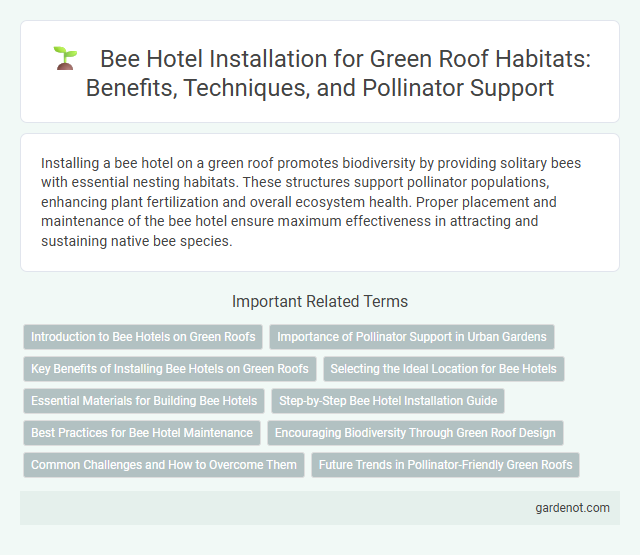Installing a bee hotel on a green roof promotes biodiversity by providing solitary bees with essential nesting habitats. These structures support pollinator populations, enhancing plant fertilization and overall ecosystem health. Proper placement and maintenance of the bee hotel ensure maximum effectiveness in attracting and sustaining native bee species.
Introduction to Bee Hotels on Green Roofs
Bee hotels provide essential nesting habitats for solitary bees, enhancing pollination on green roofs. Installing bee hotels on green roofs supports biodiversity by offering shelter and breeding sites in urban environments. These structures contribute to sustainable green roof ecosystems by promoting native bee populations and improving plant health.
Importance of Pollinator Support in Urban Gardens
Bee hotel installation on green roofs fosters urban biodiversity by providing essential nesting habitats for solitary pollinators like mason bees and leafcutter bees. These structures enhance pollination services, boosting the growth and health of urban gardens and green spaces. Supporting pollinator populations in cities is critical for maintaining ecological balance and promoting sustainable urban agriculture.
Key Benefits of Installing Bee Hotels on Green Roofs
Installing bee hotels on green roofs enhances urban biodiversity by providing essential habitats for solitary bees, which are crucial pollinators for many plants. These structures support the lifecycle of native bee species, improving pollination rates and contributing to healthier, more resilient rooftop ecosystems. Bee hotels also promote environmental education and awareness, encouraging sustainable practices within urban settings.
Selecting the Ideal Location for Bee Hotels
Selecting the ideal location for bee hotels involves choosing a sunny, sheltered spot with minimal wind exposure to support bee activity. Proximity to flowering plants and native vegetation ensures adequate food sources for pollinators, enhancing biodiversity on green roofs. Elevating bee hotels away from ground-level predators and moisture helps maintain a safe environment for solitary bees to nest and thrive.
Essential Materials for Building Bee Hotels
Essential materials for building bee hotels include untreated wood blocks with pre-drilled holes of varying diameters ranging from 2mm to 10mm to accommodate different solitary bee species. Bamboo canes or hollow plant stems provide ideal nesting tubes, while a layer of dried leaves or straw adds insulation and mimics natural habitats. Using non-toxic, weather-resistant materials ensures the longevity of the bee hotel and promotes a safe breeding environment for pollinators.
Step-by-Step Bee Hotel Installation Guide
Install a bee hotel on a green roof by selecting a sheltered location with ample sunlight and minimal wind exposure. Assemble the hotel using untreated wooden blocks with drilled holes of varying diameters to accommodate different bee species, then securely mount it on a stable surface at least three feet above the roof base. Regularly maintain the bee hotel by cleaning out debris and replacing damaged blocks annually to ensure a thriving pollinator habitat.
Best Practices for Bee Hotel Maintenance
Regularly clean bee hotels by removing old nests and debris to prevent parasite buildup and disease. Position bee hotels in sunny, sheltered locations with nearby flowering plants to support bee foraging and reproduction. Replace damaged or worn nesting materials annually to maintain a safe and attractive habitat for solitary bees.
Encouraging Biodiversity Through Green Roof Design
Bee hotel installation on green roofs creates vital nesting habitats that support native pollinator populations, enhancing urban biodiversity. Strategically placed bee hotels combined with diverse flowering plants promote ecological balance and improve pollination services. This integration transforms green roofs into thriving ecosystems that sustain local wildlife and contribute to environmental resilience.
Common Challenges and How to Overcome Them
Bee hotel installation on green roofs often faces challenges such as limited space, exposure to harsh weather, and difficulty attracting native pollinators. To overcome these obstacles, using modular, weather-resistant materials and strategically placing hotels near flowering plants can enhance habitat suitability. Incorporating a diversity of nesting cavities tailored to local bee species increases occupancy rates and supports pollinator biodiversity.
Future Trends in Pollinator-Friendly Green Roofs
Bee hotel installation on green roofs is emerging as a pivotal trend to enhance urban biodiversity by providing essential nesting habitats for solitary pollinators. Advanced designs incorporate sustainable materials and modular structures tailored to diverse bee species to improve pollination efficacy and ecosystem resilience. Integrating smart monitoring technologies enables real-time data collection on pollinator activity, guiding adaptive management strategies for future pollinator-friendly green roof developments.
Bee hotel installation Infographic

 gardenot.com
gardenot.com